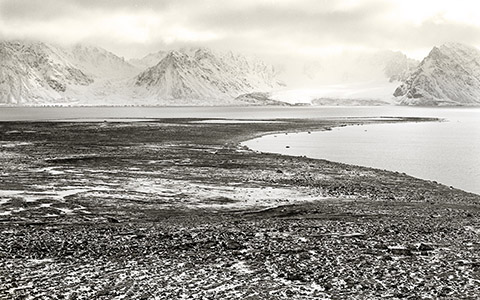
Looking back at Svalbard 79
A rough journey
The Amsterdam Island peninsula, with the settlement of Smeerenburg on its very tip.
Studying a grave on the neighbouring island Zeeuwse Uitkijk.
Snowstorms, polar bears, and dwindling food supplies: the expedition to Svalbard that archaeologist Louwrens Hacquebord undertook with six of his students in 1979 was a dangerous journey. For six weeks, they stayed in tents on Amsterdam Island, studying the seventeenth-century Dutch whaling settlement of Smeerenburg.
It was a memorable journey, for several reasons: not just the awful conditions and the fact that this was the RUG’s first archaeological expedition to Svalbard, but also because it was the first time that scientific research was being funding by the business world.
Now, forty years later, the University Museum is showing the photographs taken by expedition member and scientific photographers Ben Bekooy. Also on display are materials that the researcher brought back to Groningen from Svalbard.
Sixteen days
‘It was a different time’, says expedition leader Hacquebord, remembering. ‘We had hardly any provisions, and there were very few ships.’ The group first flew to Longyearbyen, the largest settlement on Svalbard. Soon after, however, everything went awry. ‘We got stuck. The ship we’d chartered didn’t show up, because the captain didn’t have the right papers.’
They boarded a tourist ship, but rough winds prevented them from mooring at Amsterdam Island and they were forced to turn around. ‘It took sixteen days to reach our destination. We had no idea how we were supposed to get back, though. We were pretty worried about it.’
In spite of all the hardships, the expedition led to many new insights. The young archaeologists recorded everything about Smeerenburg. They found graves, sleeping caps, and the remains of sixteen houses, as well as seven ovens that were used to distil the train from whale blubber. ‘It was a resource back then. People use to make soap and candles with it, and it was used as lamp fuel’, says Hacquebord.
Impact
They studied the influence of the whaling industry on the environment. ‘After two hundred years, the settlers ran out of whales’, says Hacquebord. ‘That affected the ecosystem. The Dutch whalers’ stay also impacted the vegetation on the island: it took 150 years before it recovered.’
The exhibition also covers current research done by the RUG Arctic Centre into climate change. In August of next year, another scientific expedition will leave for Svalbard. Its researchers will continue the work done during the 1979 expedition.
The exhibition at the University Museum will last until March 1.
Photos by Ben Bekooy /Translation by Sarah van Steenderen

